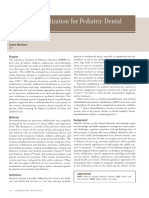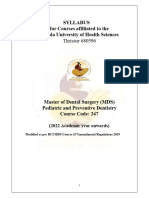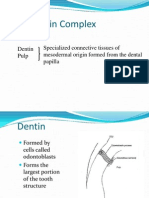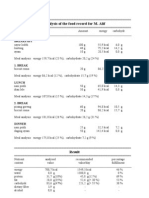Dental Anxiety
Dental Anxiety
Uploaded by
Lau Kien YeeCopyright:
Available Formats
Dental Anxiety
Dental Anxiety
Uploaded by
Lau Kien YeeCopyright
Available Formats
Share this document
Did you find this document useful?
Is this content inappropriate?
Copyright:
Available Formats
Dental Anxiety
Dental Anxiety
Uploaded by
Lau Kien YeeCopyright:
Available Formats
Suggest two aspects of dental treatment that causes patient anxiety in dentistry Two aspects that causes patients
anxiety are fear of unknown which means, the patient does not know how it is going to feel and afraid because she/he never gone through this particular treatment and awful dental treatment experience. For each item listed, describe what you, as a dentist could do to reduce anxiety 1. Communication Staff-patient communication with patients plays a very important role in anxiety reduction. Establishing trust and keeping patients informed and in control throughout a visit to the dentist helps calm dental anxiety. One option is for patients to use hand signals to communicate with the dentist throughout a procedure. When a patient feels uncomfortable, he or she can signal the dentist and the dentist stops the procedure. This method of communication empowers patients and makes visiting the dentist less stressful for them. 2. Behavioural techniques i) Disensitization It is a training procedure/steps taken to reduce sensitivity of patient to particular anxiety producing situation/object. Each situation/ object is introduced progressively starting from least fear producing to more threatening stimuli. Three stages are involved, training patient to relax, constructing hierarchy of fear producing stimuli related to patientss principal fear and lastly introducing each stimulus in the hierarchy in turn to the relaxed patient, starting with the stimuli that causes less fear and progressing to the next when the patient no longer fear the stimulus. For example, if a child patient is frightened to restorations, disensitization includes successive introduction of child to reception, dentist, dental chair, oral examination, oral prophylaxis and restorations. ii.) Tell-show-do The tell-show-do technique was originally developed for use in pediatric dentistry, but can also be used with nervous adult patients. The technique involves verbal explanations of procedures in easy-to-understand language (tell), followed by demonstrations of the sights, sounds, smells, and tactile aspects of the procedure in a non-threatening way (show), followed by the actual procedure (do).
iii.) Relaxation techniques Other behavioral treatments include teaching individuals relaxation techniques, such as diaphragmatic breathing and progressive muscle relaxation. This method can be very effective in motivated and cooperative patients, and can be used before and during treatment. 3. Sedation Dentists may prescribe an oral sedative, such as a benzodiazepine. Conscious sedation techniques are reliable and safe for managing dental anxiety, while more severely anxious and uncooperative patients can be treated under general anaesthesia. Agents such as nitrous oxide and oxygen are inhaled through a mask and cause feelings of relaxation and dissociation. 4. Operative technique Atraumatic restorative technique (ART) method has been used extensively in dentistry for conservative management of open cavitations in dentine, without need for injected local anaesthesia. On the other hand, chemo-mechanical caries removal (Carisolv) is a minimally invasive method, which involves the dentine during cavity preparation, as a form of accelerated ART. The other options are such as air abrasion and middle infrared lasers may now also be considered alternative methods for tooth preparation and caries removal.Use of these novel methods may be effectively targeted to anxious dental patients, where the different methods reduce the major stimuli for anxiety and also provide a distraction effect, thus giving overall a reduction in dental anxiety. 3. Why is this important for dental health professional to assess patients fear? It is important that a patient tell the doctor if they have any dental anxiety related to their planned dental treatment. Keeping their fears hidden can only lead to a much more unpleasant experience for the patient and, in more extreme circumstances, may even increase the likelihood of certain emergencies occurring, such as fainting. Avoiding the dentist because of fear may cause an individual's minor untreated dental problems to develop into severe oral health conditions and in rare cases even death. When fear is not corrected, it can become harder to get the patient to participate in dental procedures causing a total avoidance of dental visits, which can lead to poor hygiene and lack of proper care for their teeth. This expectance of pain leads many to miss appointments and be unwilling to seek professional help for simple things like toothaches. These simple things can lead to larger problems resulting in decaying teeth and poorly cared for gums. Anxious patients may delay dental treatment or miss appointments without explanation leading to a deterioration of their dental condition.
air abrasion, chemo-mechanical caries removal and middle
You might also like
- Textbook of Pediatric Dentistry-3rd EditionDocument18 pagesTextbook of Pediatric Dentistry-3rd EditionAnna NgNo ratings yet
- Protective Stabilization For Pediatric Dental PatientsDocument6 pagesProtective Stabilization For Pediatric Dental Patientsangela faustina0% (1)
- Pedo 2016-18 PDFDocument4 pagesPedo 2016-18 PDFJude Aldo PaulNo ratings yet
- Innocent Drinks (Smoothie)Document31 pagesInnocent Drinks (Smoothie)Swapnil RajebhosaleNo ratings yet
- Management of Fear & Anxiety - A Review 2013Document19 pagesManagement of Fear & Anxiety - A Review 2013AnimeAngelNo ratings yet
- Emergency Dental Care: A Comprehensive Guide for Dental Patients: All About DentistryFrom EverandEmergency Dental Care: A Comprehensive Guide for Dental Patients: All About DentistryNo ratings yet
- The Complete Guide to Dental Anxiety: Understanding and Overcoming Your Fear: All About DentistryFrom EverandThe Complete Guide to Dental Anxiety: Understanding and Overcoming Your Fear: All About DentistryNo ratings yet
- Medical Emergency in Paediatric Dental ClinicDocument75 pagesMedical Emergency in Paediatric Dental ClinicAkshay Sreeraman KecheryNo ratings yet
- MDS Pediatric and Preventive DentistryDocument61 pagesMDS Pediatric and Preventive DentistryfathimapedoNo ratings yet
- Journal Laser and Its Use in Pediatric Dentistry A ReviewDocument5 pagesJournal Laser and Its Use in Pediatric Dentistry A ReviewTiaraNo ratings yet
- General Anesthesia in Pediatric DentistryDocument23 pagesGeneral Anesthesia in Pediatric DentistryAlya ElgamriNo ratings yet
- Comparative Evaluation of Intranasal, Buccal and Oral Midazolam For Procedural Sedation in Pediatric Dental Patients.Document5 pagesComparative Evaluation of Intranasal, Buccal and Oral Midazolam For Procedural Sedation in Pediatric Dental Patients.Bibhav DubeyNo ratings yet
- Special Care Dentistry Curriculum 2012Document72 pagesSpecial Care Dentistry Curriculum 2012Yahya SalmanNo ratings yet
- Case Report: M E C C C S AC RDocument3 pagesCase Report: M E C C C S AC RRaja Dean Collin SiagianNo ratings yet
- Dentistry: Dentistry Is A Branch of MedicineDocument10 pagesDentistry: Dentistry Is A Branch of MedicineMrWolf23No ratings yet
- Child AbuseDocument16 pagesChild AbuseKynachasya' RiverNo ratings yet
- DR Nick Lekic - Space MaintainersDocument35 pagesDR Nick Lekic - Space MaintainersanatomimanusiaNo ratings yet
- Rehabilitation of Molar-Incisor Hypomineralization (MIH) Complicated With Localized Tooth Surface Loss 2014Document3 pagesRehabilitation of Molar-Incisor Hypomineralization (MIH) Complicated With Localized Tooth Surface Loss 2014player osamaNo ratings yet
- Biological Restorations in Children: January 2016Document4 pagesBiological Restorations in Children: January 2016Mel LlerenaNo ratings yet
- Dentalindices 150810132800 Lva1 App6892 PDFDocument132 pagesDentalindices 150810132800 Lva1 App6892 PDFNitya KrishnaNo ratings yet
- Epidemiology of Dental Caries 2020Document58 pagesEpidemiology of Dental Caries 2020zahra.mohmed2816No ratings yet
- Non-Caries Dental DiseaseDocument61 pagesNon-Caries Dental Diseaseapi-19916399No ratings yet
- (RestoDent) Dentin-Pulp ComplexDocument28 pages(RestoDent) Dentin-Pulp ComplexZara Sebastianne GarciaNo ratings yet
- Lecture 5 Disorders of The Dental Pulp SlideDocument23 pagesLecture 5 Disorders of The Dental Pulp SlideDentist Freebooks100% (2)
- Enamel Microabrasion in Pediatric Dentistry CaseDocument7 pagesEnamel Microabrasion in Pediatric Dentistry Casekhalisha salsabilaNo ratings yet
- Lasers in Pediatric Dentistry - 2Document82 pagesLasers in Pediatric Dentistry - 2Shameena KnNo ratings yet
- Epidemiologi Dental CariesDocument21 pagesEpidemiologi Dental CariesSampahAjaNo ratings yet
- Avulsion: DEFINITION: - Tooth Avulsion (Exarticulation) Implies Total Displacement of The ToothDocument39 pagesAvulsion: DEFINITION: - Tooth Avulsion (Exarticulation) Implies Total Displacement of The Toothshailesh_shenoyNo ratings yet
- Space Regainers in Pediatric DentistryDocument6 pagesSpace Regainers in Pediatric DentistryDiba Eka DiputriNo ratings yet
- MIH An OverviewDocument9 pagesMIH An OverviewLaura QuinteroNo ratings yet
- Introduction To Paediatric DentistryDocument48 pagesIntroduction To Paediatric DentistryReda Ismaeel100% (1)
- International Caries Detection and Assessment System (ICDAS) PDFDocument4 pagesInternational Caries Detection and Assessment System (ICDAS) PDFKelvin Jaya AlamNo ratings yet
- Intra Canal Medicaments-2Document58 pagesIntra Canal Medicaments-2FadilaNo ratings yet
- Pre-And Postoperative Management Techniques. Before and After. Part 1: Medical MorbiditiesDocument6 pagesPre-And Postoperative Management Techniques. Before and After. Part 1: Medical MorbiditiesMostafa FayadNo ratings yet
- General Dental Syllabus and Guidance NotesDocument23 pagesGeneral Dental Syllabus and Guidance NotesRajitha DilhanNo ratings yet
- JISPPD Supplement 19 PDFDocument71 pagesJISPPD Supplement 19 PDFHARSH KUMARNo ratings yet
- Lecture 2 2021Document7 pagesLecture 2 2021Mateusz RadwańskiNo ratings yet
- Identifying andDocument9 pagesIdentifying andVinisha Vipin SharmaNo ratings yet
- Gingival and Periodontal Diseases in ChildrenDocument80 pagesGingival and Periodontal Diseases in ChildrenSonam RawatNo ratings yet
- Management of Medically Compromised Patients in Oral SurgeryDocument30 pagesManagement of Medically Compromised Patients in Oral SurgeryLaiba Asif RajputNo ratings yet
- A Review On Obturating Materials For Deciduous DentitionDocument7 pagesA Review On Obturating Materials For Deciduous DentitionIJAR JOURNALNo ratings yet
- Caries MGMNT (Adj)Document9 pagesCaries MGMNT (Adj)jiwanjyotkaurNo ratings yet
- Modern Pediatric Dentistry PDFDocument14 pagesModern Pediatric Dentistry PDFsana alia0% (1)
- Caries Risk Assessment by DR TegaDocument45 pagesCaries Risk Assessment by DR TegaRock Ogosobrugwe50% (2)
- Amelogenesis ImperfectaDocument11 pagesAmelogenesis Imperfectamapecorelli2626No ratings yet
- Periodontal Problems in KidsDocument49 pagesPeriodontal Problems in KidsRaksmey PhanNo ratings yet
- BSDH Domiciliary Guidelines August 2009Document40 pagesBSDH Domiciliary Guidelines August 2009joquitoNo ratings yet
- Pharmacological Methods of Behaviour ManagementDocument41 pagesPharmacological Methods of Behaviour ManagementSuma 123No ratings yet
- Conscious Sedation in DentistryDocument4 pagesConscious Sedation in DentistryHarees ShabirNo ratings yet
- Cracked Tooth SyndromDocument19 pagesCracked Tooth SyndromNUHA ELKADIKINo ratings yet
- Prolonged Retention, Ankylosis and Infraocclusion of Deciduous Teeth Ok OkDocument5 pagesProlonged Retention, Ankylosis and Infraocclusion of Deciduous Teeth Ok OkRahulLife'sNo ratings yet
- Role of A Pedodontist in Cleft Lip and Cleft Palate Rehabilitation - An OverviewDocument25 pagesRole of A Pedodontist in Cleft Lip and Cleft Palate Rehabilitation - An OverviewIJAR JOURNALNo ratings yet
- Pulp Therapy of Non-Vital Teeth (Pulpectomy)Document27 pagesPulp Therapy of Non-Vital Teeth (Pulpectomy)Mahmoud A. Zoghbor100% (1)
- Self Applied Topical Fluorides ClassDocument23 pagesSelf Applied Topical Fluorides ClassultraswamyNo ratings yet
- Periodontic-Endodontic Lesions PDFDocument6 pagesPeriodontic-Endodontic Lesions PDFdanielaNo ratings yet
- Dental CariesDocument29 pagesDental CariesMayank AggarwalNo ratings yet
- Full Coverage Restoration For Primary TeethDocument24 pagesFull Coverage Restoration For Primary TeethMohamed ElkafrawyNo ratings yet
- Dental Management of Medically Compromised Patients 2Document85 pagesDental Management of Medically Compromised Patients 2Mohamed KhaledNo ratings yet
- Management of Pediatric Medical - Emergencies in The Dental OfficeDocument22 pagesManagement of Pediatric Medical - Emergencies in The Dental Officebanyubiru0% (1)
- Surgical Complications in Oral Implantology: Etiology, Prevention, and ManagementFrom EverandSurgical Complications in Oral Implantology: Etiology, Prevention, and ManagementNo ratings yet
- Minimally Invasive Periodontal Therapy: Clinical Techniques and Visualization TechnologyFrom EverandMinimally Invasive Periodontal Therapy: Clinical Techniques and Visualization TechnologyNo ratings yet
- Unit 3-OutpatientDocument38 pagesUnit 3-OutpatientSharmila LamisharNo ratings yet
- MBBS 2ND Year 2024 - 27-08-2024Document1 pageMBBS 2ND Year 2024 - 27-08-2024sohamsadhukhan859No ratings yet
- Restaurant Report Card - July 29, 2021Document5 pagesRestaurant Report Card - July 29, 2021KBTXNo ratings yet
- Microsoft PowerPoint - IG1 Element 4Document19 pagesMicrosoft PowerPoint - IG1 Element 4saadNo ratings yet
- Ekran Resmi 2024-02-29 - 20.12.30Document46 pagesEkran Resmi 2024-02-29 - 20.12.308qpk4zg7ryNo ratings yet
- Dukun Beranak: Indonesia's Birth WitchdoctorsDocument5 pagesDukun Beranak: Indonesia's Birth WitchdoctorsVerene Ysabell Litenia -No ratings yet
- ReAssure Policy WordingsDocument27 pagesReAssure Policy Wordingsmindhunter786No ratings yet
- Bài Tập Tiếng Anh Cơ Bản Cho Người Mất GốcDocument23 pagesBài Tập Tiếng Anh Cơ Bản Cho Người Mất Gốcphong minhNo ratings yet
- Ntu Coursework Cover SheetDocument7 pagesNtu Coursework Cover Sheetafaydoter100% (2)
- ID Beban Kerja Perawat Terhadap ImplementasDocument9 pagesID Beban Kerja Perawat Terhadap ImplementasdewimulfiyantiNo ratings yet
- Inims College: "An Organizational Study" Kanva Diagnostic PVT LTD, BangaloreDocument60 pagesInims College: "An Organizational Study" Kanva Diagnostic PVT LTD, BangaloreMeghana Shree Sr.No ratings yet
- A Clinically Oriented Complete Denture Program For Second-Year Dental StudentsDocument8 pagesA Clinically Oriented Complete Denture Program For Second-Year Dental StudentsBrijesh MaskeyNo ratings yet
- Work-Life Benefits and Job Pursuit Intentions PDFDocument20 pagesWork-Life Benefits and Job Pursuit Intentions PDFDixon Choo100% (1)
- Winger Et Al (2022) Designing Psychosocial Intervention Pilot StudiesDocument7 pagesWinger Et Al (2022) Designing Psychosocial Intervention Pilot StudiesJuana Camila Lobo SierraNo ratings yet
- Ankle SprainDocument34 pagesAnkle Sprainاثير اااNo ratings yet
- Indigenous Student Success Survey ReportDocument76 pagesIndigenous Student Success Survey ReportJade LimbagaNo ratings yet
- What Causes Oral HematomaDocument2 pagesWhat Causes Oral HematomaAlvia D L CaninaNo ratings yet
- 2.1. Conditions Training of Young Handball Players PDFDocument9 pages2.1. Conditions Training of Young Handball Players PDFМилан ПанчићNo ratings yet
- MRNA Vaccines - Day - 04.14.20 PDFDocument259 pagesMRNA Vaccines - Day - 04.14.20 PDFTammy G100% (1)
- Analysis of The Food Record For M. Alif: BreakfastDocument2 pagesAnalysis of The Food Record For M. Alif: BreakfastHamid Rifki BaharunNo ratings yet
- Interprofessional Practice Related in PharmacologyDocument32 pagesInterprofessional Practice Related in PharmacologyJudy Baruiz100% (1)
- Analyzing Managerial ActivitiesDocument17 pagesAnalyzing Managerial ActivitiesLet's do itNo ratings yet
- Insurance Ombudsman: You Can Approach The Ombudsman With Complaint IfDocument4 pagesInsurance Ombudsman: You Can Approach The Ombudsman With Complaint IfArpit GuptaNo ratings yet
- Stoudt Woman Healers Medieval Germn WomanDocument14 pagesStoudt Woman Healers Medieval Germn WomanAdolfo BaqueiroNo ratings yet
- Eating The Right Foods For ExerciseDocument6 pagesEating The Right Foods For ExerciseKaye Ruzzel Tambo-ongNo ratings yet
- Soc Assignment-Social ClassesDocument6 pagesSoc Assignment-Social Classespamogelo.20No ratings yet
- Mid-Term Test 2 (Questions Only)Document7 pagesMid-Term Test 2 (Questions Only)PeiYi TanNo ratings yet
- Relationship Between ICUDesignandmortalityDocument9 pagesRelationship Between ICUDesignandmortalityVengky UtamiNo ratings yet
- Ill Effects of Dangerous DrugsDocument53 pagesIll Effects of Dangerous DrugsJL Dela Cruz NaragNo ratings yet

























































































